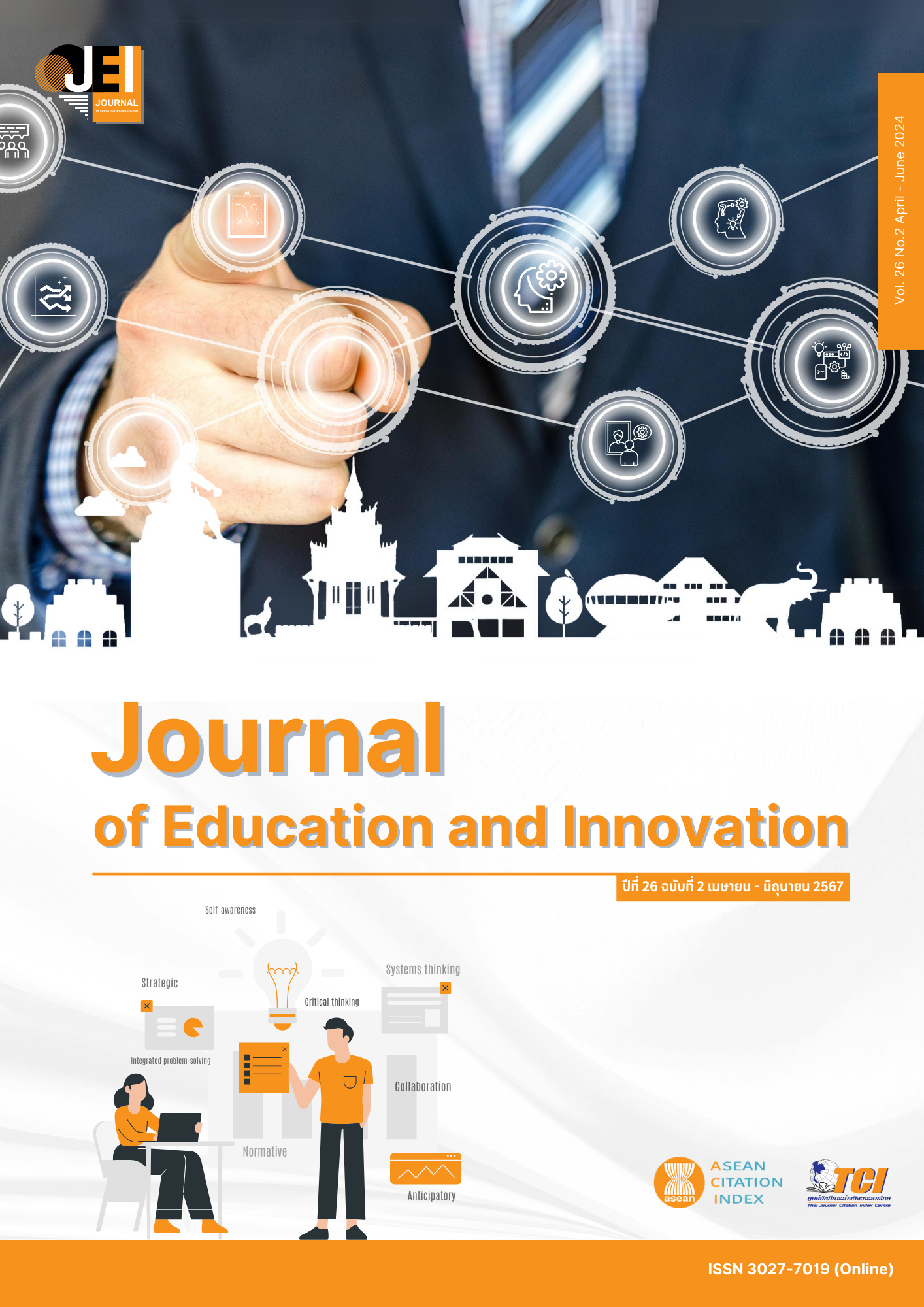การศึกษาความสามารถในการแก้ปัญหาอย่างสร้างสรรค์หลังการจัดการเรียนรู้ผสมผสาน ตามรูปแบบ 3CM (Cool-Critical-Creative-Meaningful) เรื่อง ความน่าจะเป็น ของนักเรียนชั้นมัธยมศึกษาปีที่ 3
Main Article Content
บทคัดย่อ
การวิจัยครั้งนี้มีวัตถุประสงค์เพื่อเปรียบเทียบความสามารถในการแก้ปัญหาอย่างสร้างสรรค์ เรื่อง ความน่าจะเป็น ของนักเรียนชั้นมัธยมศึกษาปีที่ 3 หลังได้รับการจัดการเรียนรู้ผสมผสานตามรูปแบบ 3CM กับเกณฑ์ร้อยละ 80 ประชากรของการวิจัยครั้งนี้ คือ นักเรียนชั้นมัธยมศึกษาปีที่ 3 โรงเรียนวังจันทร์วิทยา ภาคเรียนที่ 2 ปีการศึกษา 2565 และกลุ่มตัวอย่างของการวิจัยครั้งนี้ คือ นักเรียนชั้นมัธยมศึกษาปีที่ 3/2 จำนวน 38 คน ได้มาโดยวิธีการสุ่มแบบกลุ่ม (Cluster Random Sampling) โดยใช้ห้องเรียนเป็นหน่วยการสุ่ม เครื่องมือที่ใช้ในการวิจัย ประกอบด้วย แผนการจัดการเรียนรู้ผสมผสานตามรูปแบบ 3CM เรื่อง ความน่าจะเป็น ชั้นมัธยมศึกษาปีที่ 3 และแบบทดสอบวัดความสามารถในการแก้ปัญหาอย่างสร้างสรรค์ เรื่อง ความน่าจะเป็น วิเคราะห์ข้อมูลโดยใช้สถิติเชิงพรรณนา ได้แก่ ร้อยละ ค่าเฉลี่ย ส่วนเบี่ยงเบนมาตรฐาน และทดสอบสมมติฐานโดยใช้ One-Sample t-test ผลการวิจัย พบว่า ความสามารถในการแก้ปัญหาอย่างสร้างสรรค์ เรื่อง ความน่าจะเป็น ของนักเรียนชั้นมัธยมศึกษาปีที่ 3 หลังได้รับการจัดการเรียนรู้ผสมผสานตามรูปแบบ 3CM สูงกว่าเกณฑ์ร้อยละ 80 อย่างมีนัยสำคัญทางสถิติที่ระดับ .05 และนักเรียนมีระดับความสามารถในการแก้ปัญหาอย่างสร้างสรรค์อยู่ในระดับดีมาก ร้อยละ 100 เมื่อพิจารณาองค์ประกอบของความสามารถในการแก้ปัญหาอย่างสร้างสรรค์ทั้ง 4 ด้าน พบว่า นักเรียนมีความสามารถด้านการค้นพบปัญหาอยู่ในระดับดีมาก ร้อยละ 92.11 ความสามารถด้านการค้นพบแนวคิดอยู่ในระดับดีมาก ร้อยละ 94.74 ความสามารถด้านการค้นพบวิธีการแก้ปัญหาอยู่ในระดับดีมาก ร้อยละ 100 และความสามารถด้านการสร้างสรรค์ความรู้ของนักเรียนอยู่ในระดับดีมาก ร้อยละ 100
Article Details

This work is licensed under a Creative Commons Attribution-NonCommercial-NoDerivatives 4.0 International License.
เจ้าของบทความมิได้คัดลอก หรือละเมิดลิขสิทธิ์ของผู้ใด หากเกิดการละเมิดลิขสิทธิ์ ไม่ว่าวิธีใด หรือการฟ้องร้องไม่ว่ากรณีใด ๆ ที่อาจเกิดขึ้นได้ กองบรรณาธิการวารสารศึกษาศาสตร์ ไม่มีส่วนเกี่ยวข้องทั้งสิ้น ให้เป็นสิทธิ์ของเจ้าของบทความที่จะดำเนินการ
References
Boochapim, N. (2008). The development of learning outcome and analytical thinking on Thai wisdom of Matthayomsuksa two student Wathuayjawrakay Wittayakom School by inquiry-based learning (Master thesis). Nakhon Pathom: Silpakorn University.
Dale, E. (1969). Audio visual method in teaching (4th ed). New York: Holt Rinehart and Winston.
Independent Committee for Education Reform. (2019). Thai education reform mission report. Bangkok: Office of the Education Council.
Kanchanachaya, N. (2016). Creative problem-solving process instructional management. SDU Research Journal Humanities and Social Science, 12(3), 207-224.
Keereerom, N. (2021). The blended learning based on 3CM (Cool-Critical-Creative-Meaningful) model to enhance creative problem-solving ability in the topic of fraction for grade 7 students. The Golden Teak: Humanity and Social Science Journal, 28(2), 179-193.
Laowreandee, W. (2012). A study of internal supervision problems according to administrators. Nakhon Pathom: Silpakorn University.
Larasanti, R., & Prihatnani, E. (2021). Online learning with 3CM (Cool-Critical-Creative-Meaningful) and peer tutoring to improve learning outcomes and creativity. Jurnal Pendidikan dan Kebudayaan, 11(3), 271-282.
Malakul, P. (1995). Obstacles to creative problem-solving. Journal of Education, 26, 31-40.
Office of the Basic Education Commission, Ministry of Education. (2017). Indicators and core learning content mathematics department (revised version A.D. 2017) according to the basic education core curriculum A.D. 2008. Bangkok: The Agricultural Cooperative Federation of Thailand.
Office of the Education Council, Ministry of Education. (2019). Guidelines report on enhancing basic national education test results (O-NET). Nonthaburi: 21 Century.
Punpumnak, T. (2019). Learning management using SSCS model for enhance mathematics learning achievement and problem-solving skill on probability of Mathayomsuksa three students (Doctoral dissertation). Mahasarakham: Mahasarakham University.
Rizti, T. M., & Prihatnani, E. (2021). The Effectiveness of the 3CM (Cool-Critical-Creative-Meaningful) on Critical Thinking Skills of Middle School Students. Jurnal Pendidikan Matematika, 10(2), 213-224.
Sangpom, W. (2016). Lesson study on aspects of students’ mathematical thinking. Journal of Education, 27(2), 1-12.
Sornsawat, J., Kasemsukpipat, W., & Ugsonkid, S. (2018). The study of Mathayomsuksa three students’ mathematical problem-solving ability on probability after learning through SSCS Model. Mathematical Journal, 63(696), 35-51.
Sukbamrungsil, S. (2010). Motivation for the performance of Laem Chabang School of Engineering Teachers Chonburi (Master thesis). Chonburi: Burapha University.
Supapimonwan, S. (2020). Development of mathematics instructional model base on constructivism for developing creative problem-solving ability of eighth grade students (Doctoral dissertation). Chonburi: Burapha University.
Thaithani, P. (2019). Promoting intrinsic motivation among learners. Ratchaphruek Journal, 18(1), 9-19.
Wahyudi, Waluya, S. B., Suyitno, H., & Isnarto. (2019). Development of 3CM (cool-critical-creative-meaningful) learning model to increase creative thinking skill. Journal of Physics: Conference Series, 5(1), 1-9.
Wahyudi, Waluya, S. B., Suyitno, H., & Isnarto. (2019). The use of 3CM (Cool-Critical-Creative-Meaningful) model in blended learning to improve creative thinking ability in solving mathematics problem. Journal of Educational Science and Technology, 5(1), 26-38.
Yodyom, N. (2019). A study of mathematics achievement on probability using the problem-solving process of Polya for students grade 9 (Research report). Phitsanulok: Pibulsongkram Rajabhat University.

